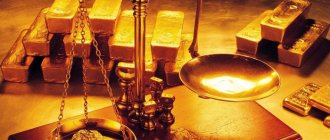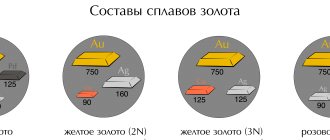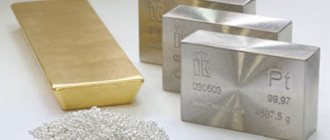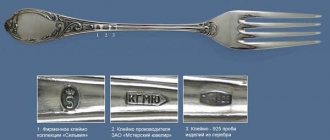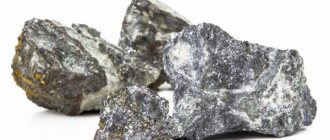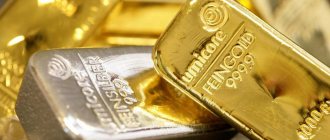Refining of precious metals is a special purification procedure. Precious metals can be subjected to it in the following form:
- technical scrap containing gold;
- gold in concentrate form;
- scrap jewelry;
- residues after electrical cleaning procedures;
- so-called “silver foam”;
- concentrates from deposits, etc.
The procedure for obtaining refined metals consists of preparation stages, which necessarily includes the process of grinding, roasting and fusion with zinc.
Refined gold
As an alternative to classical methods, electrolytic or chemical purification methods can be used for gold refining.
To obtain refined yellow metal, the chemical method is used mainly in jewelry. The method involves soaking dirty gold scrap in chemicals. Most often, iron sulfate or its sulfate is used for this. Such reagents are non-toxic and cheap, which allows them to be used even at home. The consumption of a solution of the substance to obtain 1 gram of gold is from 10 to 12 milliliters.
Sometimes jewelry makers use iron sulfate together with “aqua regia,” in which precious scrap is already dissolved. But this method is associated with losses of gold, which cannot be recovered 100%.
The best method for obtaining refined gold metal is the procedure of evaporating nitric acid in a special porcelain tank with alternate addition of ferrous sulfate and hydrochloric acid. At the bottom of the container, a reddish sediment remains, which is purified gold.
The electrolytic refining method is used in production. The raw material here is a precious metal with a purity of at least 900. It is impossible to carry out this procedure at home.
Gold refining - types and features
Two common alternative methods for refining red precious metal are electrolytic and chemical methods.
The chemical method of gold refining is most popular in jewelry workshops. Quite often it is used at home, since it is the most accessible for homemade use without special equipment. This refining method involves treating gold scrap contaminated with impurities and particles of other metals with various chemicals. Most often, ferrous sulfate (ferrous sulfate) is used for this. The advantages of using this substance lie primarily in its relatively low cost and low toxicity. To process 1 gram of gold, only about 12 grams of ferrous sulfate solution is enough.
Jewelers also add iron sulfate to aqua regia, in which scrap gold was previously dissolved. Let us immediately note that this method cannot provide a 100% yield, since its specificity is such that it is not possible to completely remove the red metal from the solution.
Refined silver
To refining silver precious metal, electrolytic and chemical methods are used, as well as the cupellation method.
In apartment conditions, to obtain refined silver metal, it is possible to use only the chemical method. In this case, silver is released from the solution in the form of sulfate, which has a black color. If you add ammonium chloride or ordinary table salt to the solution, the metal can be obtained in the form of chloride. The resulting liquid substrate is settled until it is separated into cloudy and transparent fractions. The refined silver will need to be recovered from the sediment.
How profitable are investments in refined precious metals?
Refined precious metals, as an investment object, differ from ordinary precious metals in their exceptional “purity” (fineness). Therefore, investments in such “pure” metal usually involve the purchase of bullion or the opening of compulsory medical insurance (unallocated metal accounts).
There are associated costs associated with using an investment vehicle such as bullion. Each sales transaction requires the buyer to pay VAT. And storing bullion precious metal in a bank is a paid service. Despite this, such an investment in a refined precious metal, be it palladium, silver, platinum or gold, can be very attractive and profitable.
Refined or “pure” metal is always a profitable investment instrument. But here it is important to correctly understand the timing of investment placement, which can be at least 2-3 years. Only such a time period allows us to understand the price dynamics of the market and choose the optimal moment to sell assets. You also need to know that finding a buyer for bullion to conclude a mutually beneficial deal usually takes a lot of time.
A simpler method of investing in “pure” precious metals is to open a compulsory medical insurance. It allows you to become the owner of bullion without having them in your hands, and without incurring the costs of transportation, storage, etc. Profit from compulsory medical insurance depends on the difference between the purchase price and the sale price of the precious metal.
Refined precious metals have an unconditional value that does not decrease over time. They are not subject to inflation and external economic influences. Therefore, the prospects, profitability and security of investing in them are indisputable.
ASTER
Refining - (French <afftnage> from affiner - to purify), obtaining noble metals of high purity. Refining is just one of the varieties of the refining process, i.e. metal cleaning. Refining methods are divided into electrolytic, wet and dry.
Electrolytic methods are mainly used for refining gold and silver; consist in the deposition of pure metal on the cathode with the simultaneous release of impurities in the form of sludge. Gold obtained by this method has a purity of at least 999.9%.
The advantage of electrolytic refining methods is the lower cost of the process, a high degree of metal purification, favorable conditions for workers and the possibility of obtaining platinum group metals as by-products (by adding chemical agents to the spent electrolyte).
Wet refining methods are used to obtain silver, gold, platinum, palladium, iridium, rhodium and other metals of this group according to a complex scheme with the dissolution of metals in aqua regia and their sequential isolation from the solution using various reagents (ammonium chloride, ammonia, sugar, etc.) .
Aqua regia , a mixture of concentrated acids - hydrochloric HCl and nitric HNO3 (3: 1 by volume). Yellow liquid that smells of chlorine and nitrogen oxides. It has a strong oxidizing ability due to the release of chlorine as a result of reactions;
3HCI + HNO3 = CI2 + NOCI + 2H20 2NOCI = 2NO + Cl2.
Dissolves all metals, including Au (hence the name “color”, given by alchemists who considered gold the “king of metals”), with the exception of Ag, Eh and Ir. It is used as a reagent in chemical laboratories, in the refining of Au and Pt, in the production of metal chlorides, etc.
Dry gold refining methods involve treating the molten metal, usually with chlorine. In this case, all base metals form chlorides and evaporate, and silver chloride floats to the surface of pure molten gold. The purity of gold is 996.5%, and the purity of silver (when it is reduced from chlorides) is 999.0%. Refining in industry is the process of separating metals (gold, platinum, silver) from impurities in order to obtain a final product of high purity.
Sample (German, Probe, from Latin probo - test, evaluate) of precious metals, the quantitative content of gold, silver, platinum or palladium in the alloy from which jewelry, denture discs, coins, medals, etc. are made. In most countries it is accepted metric system for designating a sample, the USSR introduced it on November 15, 1927. According to this system, a sample is designated by the number of parts of noble metal in 1000 parts (by weight) of the alloy. According to the carat system adopted in the USA, Great Britain and Switzerland, 1000% purity of metal corresponds to 24 conventional units called carats. Until 1927, Russia had a spool system for designating the sample (based on the Russian pound, containing 96 spools), according to which the sample was expressed by the weight amount of metal in 96 alloy units. The sample of precious metal alloys from which it is permitted to make jewelry and other products is established by law. The hallmark is guaranteed by the state, for which the products must undergo hallmark control (testing and analysis) and hallmark stamps are applied to them. Ingots of precious metals are stamped with a fineness determined in the alloy. Orders, award medals and coins are not subject to hallmarking, although the hallmark of their alloys is strictly regulated and controlled. Control over the hallmark of alloys and products is carried out by assay inspections.
In Russia, state marking of products was legalized for silver - in 1613, gold - in 1700, in the USSR platinum - in 1927, palladium - in 1956.
Alloy in metallurgy , auxiliary alloys used to introduce alloy elements into liquid metal. Alloys are also called metals that are introduced into noble metals (gold, silver, etc.) to give them the desired properties (for example, hardness) or reduce the cost of products. Copper, nickel and other metals are used as alloys.
But if refining is a term inherent directly in the methods of technological processing related specifically to the purification of precious metals, then refining of metals is a more generalized process for a number of technological manipulations used in the metallurgical and mining industries, but also serves for the purpose of purifying metals from all kinds of impurities and for separating mined materials. metals
Basically, rough metals obtained from raw materials contain 96-99% base metal, the rest being impurities. Such metals cannot be used by industry due to their low physical, chemical and mechanical properties. Impurities contained in rough metals can be of independent value. Thus, the cost of gold and silver extracted from copper completely covers all refining costs. There are three main refining methods: pyrometallurgical, electrolytic and chemical. All methods are based on the difference in the properties of the elements being separated: melting points, density, electronegativity of chemical activity, etc. To obtain pure metals, several refining methods are often used in succession.
Pyrometallurgical refining , carried out at high temperatures in melts, has a number of varieties.
Electrolytic refining , which is the electrolysis of aqueous solutions or molten salts, allows one to obtain high-purity metals. Used for deep cleaning of most non-ferrous metals.
Chemical refining is based on the different solubility of the metal and impurities in solutions of acids or alkalis. Impurities that gradually accumulate in the solution are separated from it chemically (hydrolysis, cementation, formation of sparingly soluble compounds, purification using extraction or ion exchange).
A particular example of chemical refining is the refining of precious metals. Gold refining is carried out in boiling sulfuric or nitric acid. Impurities of Cu, Ag and other metals dissolve, and the purified gold remains in an insoluble sediment. It is also necessary to pay special attention to other methods of chemical refining, because all further narration directly about refining will, to one degree or another, touch upon each of the following processes: Cementation in non-ferrous metallurgy, a hydrometallurgical process based on the displacement of more electropositive metals from solutions of their compounds with less electropositive metals in the solid STATE. For example, the normal electrochemical potential of copper is + 0.344 V, zinc is 0.762 V; this potential difference allows the reaction to occur: Cu solution + Zn metal -> Zn solution + Cu metal
The greater the potential difference, the lower the residual content of the deposited metal in the solution. Cementation is widely used to purify solutions from impurities and to extract metals from solutions. The process can also be used to deposit metals from molten slag.
Extraction (from the late Latin * extractio - extraction), extraction, the process of separating a mixture of liquid or solid substances using selective solvents (extractants). Ion exchange, exchange of ions in electrolyte solutions (homogeneous ion exchange). When dilute solutions of electrolytes, such as NaCl and KNO3, are mixed, Na+, K+, NO3- and Cl ions are present in the mixture. The equilibrium state will be expressed in this case by the equation: (double exchange reaction). If one of the substances that can be formed during the interaction is less dissociated than the others, the equilibrium shifts towards the formation of a less dissociated substance. The equilibrium also shifts towards the formation of a volatile or slightly soluble product (if it is released from a given phase) according to the reactions:
Extraction in refining formula
When an equilibrium solution is evaporated, crystallization of the salt (combination of ions), which has less solubility, begins first.
————
The noble metals include silver , gold and two triads of platinum group metals: ruthenium , rhodium , palladium - light and platinum , iridium , osmium - heavy platinum metals.
Of course, the most common of all existing noble metals in everyday medicine and technology are silver and gold. Palladium, platinum and iridium are widely used in technology and medicine, however, few people are familiar with the fact that almost every day they simply “burn” platinum and palladium in their cars, but first things first. Source: https://affinage.org.ua/terminy-opredeleniya-afinazha.html
